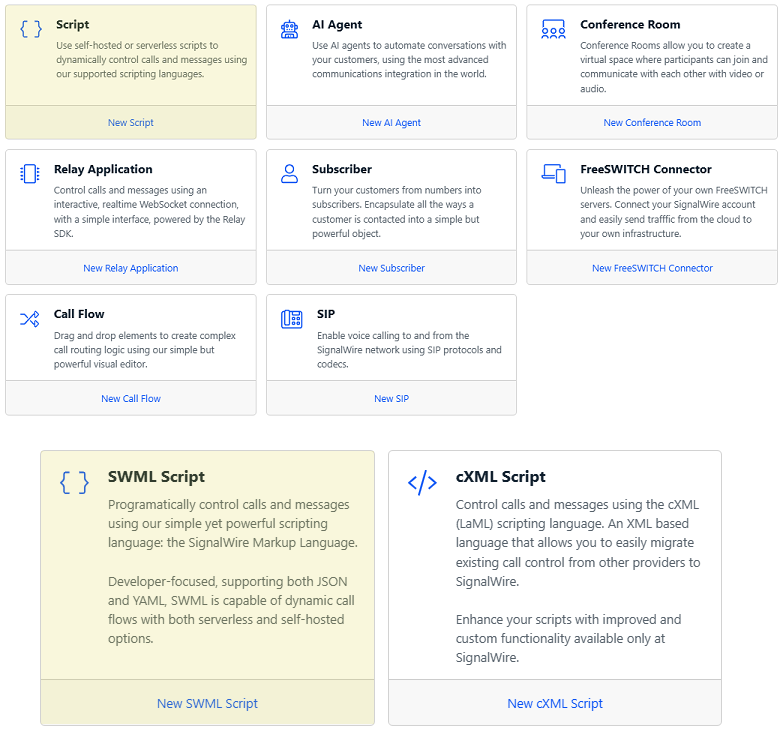Programmable Unified
Communications (PUC)
Escape the CPaaST. Build What’s Next.
All fields are required
Escape the CPaaST. Build What’s Next.
Programmable Unified Communications (PUC) is a new category of cloud communications that replaces the fragmented tools of CPaaS, UCaaS, and CCaaS with a unified, programmable model. It gives developers a new way to build, not by stitching together APIs or buying rigid software, but by using modular, cloud-native resources.
Developers get full programmatic control while teams get unified workflows across voice, video, messaging, and AI. PUC lets you build, scale, and own your communications without reinventing the infrastructure or duct-taping disconnected services together.
Voice, video, messaging, SIP, webhooks, AI: PUC brings them under one system. Fewer vendors, fewer dashboards, fewer ways things can break.
PUC is cloud-native. You don’t need to forecast traffic spikes or provision servers. Whether it’s 10 calls or 10,000, the same logic applies.
Build exactly what you need - voice menus, AI IVRs, video rooms, call centers - without managing SIP servers or writing every line from scratch.
Before PUC, cloud communications meant compromise. You could either build it all yourself with APIs (CPaaS), lock yourself into an inflexible suite (UCaaS), or spend big on specialized customer tools (CCaaS).
SignalWire offers a next-generation cloud communications platform that replaces legacy infrastructure with a fully programmable, composable system designed for ultra-low latency and high scalability. Route calls, manage SIP endpoints, build IVRs, and scale automatically. All from your code.
Call Fabric is SignalWire’s full implementation of PUC, abstracting the complexity of a telco stack into programmable Resources. Resources do it all, from using scripts to define call flows and automation to connecting AI agents to your existing FreeSWITCH. Everything is programmable, assignable, and callable, just like web APIs.

SignalWire Markup Language (SWML) is a declarative JSON/YAML framework that combines:
→ XML dialplan structure
→ Real-time call control
→ CPaaS-like cloud execution
→ Built-in methods for ai, gather, connect, live_transcribe, live_translate and more
Your product (and end users) shouldn't be at the mercy of your CPaaS's capabilities.
PUC is a new cloud communications model pioneered by SignalWire that combines the programmability of CPaaS with the unified features of UCaaS and CCaaS. It enables developers to build and control voice, video, messaging, and AI applications with full flexibility and scalability.
CPaaS gives you APIs to build features but not a unified platform. UCaaS is a prebuilt internal communication suite with limited customization. CCaaS is designed for customer support, often with fixed workflows.
PUC blends all three: unified, programmable, and open for custom development.
PUC as a category is defined by its modular, programmable architecture that combines the best of CPaaS, UCaaS, and CCaaS, but with more developer control. Key features will include declarative call control; programmable primitives like SIP endpoints, AI agents, and conferencing; REST + Real-time APIs; scalable, serverless infrastructure.
Call Fabric is SignalWire’s implementation of PUC. It provides a set of programmable building blocks called Resources, which include AI agents, rooms, call flow scripts, and subscribers that can be deployed, assigned addresses, called, and used in real-time applications via API or visual UI. We created PUC after decades of seeing developers forced to choose between duct-taping APIs together or getting locked into rigid telecom software. It’s born from the limitations we lived through building FreeSWITCH, and the belief that communications should be programmable by design.
Have a question? Reach out to our experts by filling out the form below.
Get in touch with our team of experts to learn more about our industry-leading solutions.